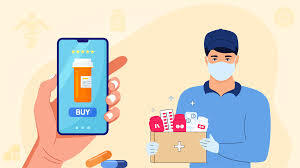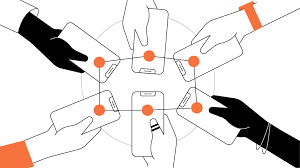From Prescription to Delivery: How Medicine Delivery Apps Work Behind the Scenes

Strong 8k brings an ultra-HD IPTV experience to your living room and your pocket.
The rise of medicine delivery apps has revolutionized the healthcare industry, providing patients with easy access to their medications without needing to visit a pharmacy. These apps offer convenience, efficiency, and often lower costs, making them an essential tool for many people. However, the process from the moment a prescription is entered into the app to when the medication arrives at a customer's door is complex and involves several critical steps. This article takes a detailed look at the logistics, technology, and processes involved, shedding light on how a medicine delivery app development company brings this convenience to life.
The Role of Medicine Delivery Apps in Modern Healthcare
Medicine delivery apps have emerged as a crucial component of modern healthcare, especially in a world where digital services are becoming the norm. These apps bridge the gap between patients and pharmacies, ensuring that medications are delivered promptly and safely. They cater to various needs, from routine prescriptions to urgent deliveries, and have become particularly vital during times of crisis, such as the COVID-19 pandemic.
For patients, these apps offer the convenience of ordering medications from home, saving time and reducing the need to visit crowded pharmacies. For healthcare providers and pharmacies, they streamline the prescription fulfillment process, allowing for better inventory management and improved customer service.
How It Begins: Prescription Entry and Verification
The process starts with the patient or healthcare provider entering a prescription into the app. In some cases, this might be as simple as uploading a photo of a handwritten prescription or choosing a previously saved prescription from the app's history.
Once the prescription is entered, the medicine delivery app's system needs to verify its validity. This involves several layers of checks, including:
Prescription Verification
The app cross-references the prescription with databases to ensure that it’s legitimate and complies with local regulations.
Doctor and Patient Authentication
The system verifies the credentials of the prescribing doctor and ensures the patient is who they claim to be. This step is crucial for preventing fraud and ensuring that the medication is appropriate for the patient’s condition.
Compliance Check
The app must ensure that the prescribed medication is not contraindicated with other medications the patient might be taking, a process often aided by integration with electronic health records (EHRs).
The Role of Technology in Medicine Delivery Apps
The backbone of any successful medicine delivery app is its technology. A well-developed app requires robust backend systems to handle the complexities of prescription management, customer data, payment processing, and logistics.
User Interface (UI) and User Experience (UX)
The front end of the app must be intuitive and easy to navigate, allowing users to quickly upload prescriptions, select medicines, and place orders. The UI/UX design is crucial in ensuring a seamless experience, from login to checkout.
Database Management
A medicine delivery app development company needs to create a secure and scalable database to store patient information, prescriptions, and transaction histories. This data must be encrypted and comply with regulations like HIPAA (Health Insurance Portability and Accountability Act) to protect patient privacy.
Payment Gateway Integration
Secure payment gateways are integrated to facilitate smooth transactions. These gateways must support multiple payment methods, including credit/debit cards, digital wallets, and sometimes even insurance claims.
AI and Machine Learning
Advanced apps often incorporate AI to predict medication needs, offer personalized recommendations, and optimize delivery routes. Machine learning algorithms can analyze user behavior to improve the app’s service over time, making it more efficient and user-friendly.
Order Processing and Pharmacy Coordination
After prescription verification, the app’s system processes the order. Here’s where coordination with local pharmacies comes into play:
Pharmacy Selection
The app’s algorithm selects a pharmacy based on factors like proximity to the customer, availability of the prescribed medication, and the pharmacy’s ability to fulfill the order within the desired timeframe.
Inventory Management
The selected pharmacy’s inventory is checked in real-time to ensure the medication is available. If the medicine is out of stock, the app might suggest alternative pharmacies or notify the user of a delay.
Prescription Fulfillment
Once the order is confirmed, the pharmacy prepares the medication for delivery. This might involve packaging the medication in tamper-proof packaging and including any necessary documentation, such as usage instructions or warnings.
Logistics: From Pharmacy to Doorstep
The logistics involved in getting the medicine from the pharmacy to the customer’s door is perhaps the most intricate part of the process. A medicine delivery app development company needs to ensure that this aspect is handled with precision to maintain customer satisfaction.
Delivery Partner Integration
Many medicine delivery apps partner with third-party delivery services. These partners are integrated into the app, allowing for real-time tracking and efficient routing. Some apps may have their fleet of delivery personnel, especially in urban areas with high demand.
Route Optimization
Using GPS and AI algorithms, the app calculates the fastest and most efficient route for delivery. This is especially crucial for time-sensitive deliveries, such as urgent medication or temperature-sensitive drugs that need to be delivered quickly.
Real-Time Tracking
Customers can track their orders in real-time, knowing exactly when their medication will arrive. This transparency helps build trust and keeps customers informed throughout the process.
Ensuring Safety and Compliance During Delivery
Safety and compliance are paramount in medicine delivery, given the sensitive nature of the products being handled.
Temperature Control
Some medications require specific temperature conditions during transit. The app’s system must ensure that these requirements are met, often by working with delivery partners who have the necessary equipment.
Verification Upon Delivery
Upon arrival, the delivery personnel may need to verify the recipient’s identity, especially for controlled substances. This step ensures that the medication reaches the intended patient.
Feedback and Support
After delivery, customers can provide feedback on the service, and any issues can be addressed promptly through customer support. This feedback loop helps the app improve its services continuously.
The Role of a Medicine Delivery App Development Company
Behind every successful medicine delivery app is a dedicated medicine delivery app development company that understands the nuances of the healthcare industry. These companies are responsible for building and maintaining the app’s infrastructure, ensuring it is secure, reliable, and scalable.
Customization
A good development company tailors the app to meet the specific needs of pharmacies, healthcare providers, and patients. This might include integrating with existing pharmacy management systems or creating features that cater to specific patient demographics.
Compliance and Security
Ensuring that the app complies with healthcare regulations and protects patient data is a top priority. Development companies must stay updated with the latest legal requirements and incorporate them into the app’s design.
Innovation
The best medicine delivery apps are those that innovate, offering features like telemedicine integration, AI-driven recommendations, and personalized care plans. A forward-thinking development company will constantly look for ways to improve the app’s functionality and user experience.
Conclusion
Medicine delivery apps have made obtaining necessary medications easier and more convenient for millions of people. However, the journey from prescription to delivery involves a complex interplay of technology, logistics, and compliance. A reliable medicine delivery app development company plays a crucial role in ensuring this process is smooth, secure, and efficient. By understanding the behind-the-scenes workings of these apps, we can better appreciate the technology and expertise that make modern healthcare more accessible.
Note: IndiBlogHub features both user-submitted and editorial content. We do not verify third-party contributions. Read our Disclaimer and Privacy Policyfor details.




